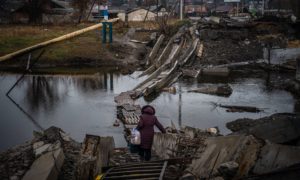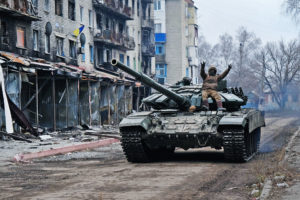The entrance to Kherson is littered with ruined market stalls that the Russians burned when they occupied the city. Inside, the centre is deserted. Cafes are shut; restaurants are boarded up. On a municipal building in Freedom Square hangs a huge McDonald’s poster, sodden with rain.
The Ukrainians retook Kherson on 11 November. But in truth, it wasn’t a victory. The Russians withdrew from the city, and they withdrew in good order. This wasn’t the perfervid flight from Kharkiv, when they left their equipment strewn across fields for the grateful, and trolling, Ukrainians to delightedly hoover up. Now, Russian forces sit on the other side of the Dnieper River, shelling the city continuously.
Southern Ukraine is vital for Moscow: it is the land bridge from the Russian Federation to its Crimea, its Crown Jewel in occupied Ukraine. But as well as needing to cut off Kyiv from Crimea, the Russians need to keep control of the atomic station in Enegodar on their side of the river. It’s the largest in Europe — and it powers much of the South.
Everywhere I’ve been in Ukraine, soldiers and civilians have spent the past weeks discussing the coming spring offensive. After so many battlefield defeats, Putin, the logic goes, cannot simply roll things up and bring his troops home. He must double down. He needs some unequivocal wins. So far, he hasn’t had much success, but what he does have are a lot of soldiers, and a political system that can send them to their deaths with little if any blowback.
In a cramped apartment, just out of central Kherson, I meet with “Sergei”, a soldier who has been fighting here since the start of last year’s invasion. Back then, he was a Platoon Commander; now he is second-in-command of the Company. “Kherson did not fall; we did not conquer it. The Russians left in an organised way,” he tells me. “My educated guess is that the Russians could not maintain supplies. During that period of intense shelling in the autumn, I felt they were using all the artillery they had left before retreating. We destroyed Kherson bridge, so it was harder for them to keep supplying the army in the city, especially with artillery. But it was still a pretty brutal period.”
September through to mid-November was particularly gruelling. Sergei’s unit was stationed a few kilometres from Kherson in a small village, responsible for several lookout points along the left bank. The Russians constantly tried to advance toward them; they had an enormous artillery advantage — and they used it. From dusk to dawn, the shelling never stopped. There would be an occasional break for an hour or so, but it was impossible to tell when it would start and when it would end.
“This war here largely centres on artillery and Special Forces activity,” he tells me. “But as infantry, our role is digging and watching and reporting, and then more digging. It’s not easy to dig new positions under constant shelling. You can’t get out and dig. You do it little by little. We found some bushes and were using viaducts left over from Soviet times. They had concrete plates inside that afforded us some cover.” He continues. “The most difficult part for my guys was that they could not really understand our role: that we had to sit there like sitting ducks and facing all that shelling. The Russians know where we are and what we are doing.”
The unit continues to keep lookout, but no one really believes the Russians will cross the river this week. They just don’t have enough strength here. Russia’s best forces are concentrated mostly in the East. The battle-hardened soldiers they have here, the airborne divisions, are now regularly being used as infantry. Sergei often fights against them. It’s clear when the better soldiers are involved: they maintain good-quality communications and move after dark with night vision. Unlike many of Putin’s troops, he explains, they know their stuff.
While they await the offensive, the Russians keep shelling Ukrainian positions from across the river, knowing full well that the Ukrainians cannot adequately respond. They are short on artillery, multiple rocket launchers (MLRS), and tanks, and can employ only small 60mm mortars by way of response, which are almost useless at that distance. “They’re just trying to terrorise us,” says Sergei. “But the locals are suffering more than us at this point. The Russians don’t seem to be targeting anything in particular — just shelling villages.”
Right now, the battle is at a stalemate. “I get the sense we are accumulating forces and the Russians are doing the same,” says Sergei. “Whether that’s for us to advance or to wait until their advance for a counterattack, I don’t know. But at this point we are lacking the armaments and the machines for this kind of fight. It will take some time.”
Terrain is everything here. The Donbas is an industrial region with a large network of roads and rails. The South, though, is mainly agricultural land. With most of the roads destroyed, and with rail networks less developed, it is harder to move troops and supplies. Much will also depend on the weather. If it is wet, the muddy Rasputitsa season will descend, clogging the fields and making them almost impossible to negotiate with heavy armour.
Now that Sergei is second-in-command, his biggest job is to keep up morale. “This is the most important job there is — I can’t go home and let someone else do it. So many of the people who were willing to participate are dead now. Our guys are tired. They want to fight until March and then bring in new guys to replace the ranks. And I have to explain to them about how we brought half a million to the Territorial Defence, and trained them up. How could we do the same with another half a million new recruits, and give them weapons, and train them? I must help them be realistic and prepare for the long run.”
There are further causes for unease. The army relies on crowdfunding for much of its non-lethal equipment, including the drones that are changing the face of the war. At the start, it was easy for Sergei and his comrades to raise money, especially for drones. The message was simple: they are saving our lives. Today, however, civilians have less money. It’s harder to find a job, many Ukrainians have gone to Europe, and a lot of families are divided, with wives and children scattered across Europe while the remaining men try to find ways to feed them. For many, sparing cash for the army is no longer an option.
All of which makes the imminent Russian offensive a greater concern. Across the East, Russian forces have stepped up attacks. Over the weekend, General Valerii Zaluzhnyi, the commander-in-chief of the Armed Forces of Ukraine, said that Moscow was carrying out approximately 50 attacks per day in the Donetsk region. Moscow also recently struck Kherson with a wave of missile strikes, damaging the railway here. Many in Ukraine think the southern offensive has now officially begun; last week, they point out, resulted in the highest Russian soldier death count since the first week of the war. This suggests Ukraine is holding its ground — but for how long?
“If we keep getting weaponry,” Sergei tells me, “if we get what our commanders are asking for, then we have a chance. Unless the Russians use nuclear weapons — in which case all bets are off.”
Disclaimer
Some of the posts we share are controversial and we do not necessarily agree with them in the whole extend. Sometimes we agree with the content or part of it but we do not agree with the narration or language. Nevertheless we find them somehow interesting, valuable and/or informative or we share them, because we strongly believe in freedom of speech, free press and journalism. We strongly encourage you to have a critical approach to all the content, do your own research and analysis to build your own opinion.
We would be glad to have your feedback.
Source: UnHerd Read the original article here: https://unherd.com/



